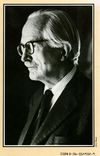Blood and Judgement: Difference between revisions
imported>Hayford Peirce (put in a link to the NYT article) |
imported>Hayford Peirce (added a paragraph) |
||
| Line 8: | Line 8: | ||
[[Anthony Boucher]], the noted mystery critic of the [[New York Times]], gave it a very favorable review, saying that: | [[Anthony Boucher]], the noted mystery critic of the [[New York Times]], gave it a very favorable review, saying that: | ||
<blockquote>Michael Gilbert has the agreeable habit of never writing the same book twice.... [This] case seems to be a simple gang killing, but evolves into something of greater psychological interest; and the detective is unorthodox but effective young Detective Sergeant Pat Petrella—a man who should have a great career if he can manage not to get kicked off the force. Despite Gilbert's insistence on variety, I shouldn't mind at all if he'd write this book again, and give us more of Petrella. <ref>''The New York Times'', 24 May 1959 at [http://timesmachine.nytimes.com/timesmachine/1959/05/24/437064262.html?pageNumber=159] </ref></blockquote> | <blockquote>Michael Gilbert has the agreeable habit of never writing the same book twice.... [This] case seems to be a simple gang killing, but evolves into something of greater psychological interest; and the detective is unorthodox but effective young Detective Sergeant Pat Petrella—a man who should have a great career if he can manage not to get kicked off the force. Despite Gilbert's insistence on variety, I shouldn't mind at all if he'd write this book again, and give us more of Petrella. <ref>''The New York Times'', 24 May 1959 at [http://timesmachine.nytimes.com/timesmachine/1959/05/24/437064262.html?pageNumber=159] </ref></blockquote> | ||
In spite of this being a novel mostly focused on the police and how they track down, arrest, and have prosecuted various professional criminals, there are still surprising twists and turns in the plotting, in which apparently straightforward assumptions and/or characters are suddenly revealed to be something completely different. And, in fact, it is not until the very last pages that we are sure that the actual perpetrator is arrested—but not yet brought to trial. | |||
==Notes== | ==Notes== | ||
Revision as of 15:01, 8 September 2016
Blood and Judgement is a police procedural novel by by the British author Michael Gilbert. Published in England in 1959 as Blood and Judgement by Hodder and Stoughton and in the United States as Blood and Judgment by Harper & Brothers, it was Gilbert's tenth novel. It introduces Gilbert's most notable series character, Patrick Petrella, as a young and somewhat controversial Detective Sergeant working out the fictional Q Division of the Metropolitan Police. The body of a woman is discovered hidden away in the bushes near a little-known part of London, the fictitious Binford Park Reservoir, which, in spite of its size, importance, and somewhat rural aspects, is relatively inconspicuous and unknown even to its closest neighbors. Although a number of policemen are featured in the book, both those at Q Division and additional members from New Scotland Yard, Petrella is the protagonist through whom we see most of the story. The story is told in what is apparently a realistic and knowledgeable depiction of how a great metropolitan police force would actually investigate this sort of crime. So-called "police procedurals" were becoming popular in the 1950s, with notable examples being the 87th Precinct novels of the American writer Ed McBain and the British novels about Commander Gideon of Scotland Yard by J.J. Marrick. Gilbert was a longtime practicing solicitor in London, and in this story, as in many others, he imbues it with a fair amount of court scenes and overall legal expertise.
Anthony Boucher, the noted mystery critic of the New York Times, gave it a very favorable review, saying that:
Michael Gilbert has the agreeable habit of never writing the same book twice.... [This] case seems to be a simple gang killing, but evolves into something of greater psychological interest; and the detective is unorthodox but effective young Detective Sergeant Pat Petrella—a man who should have a great career if he can manage not to get kicked off the force. Despite Gilbert's insistence on variety, I shouldn't mind at all if he'd write this book again, and give us more of Petrella. [1]
In spite of this being a novel mostly focused on the police and how they track down, arrest, and have prosecuted various professional criminals, there are still surprising twists and turns in the plotting, in which apparently straightforward assumptions and/or characters are suddenly revealed to be something completely different. And, in fact, it is not until the very last pages that we are sure that the actual perpetrator is arrested—but not yet brought to trial.
